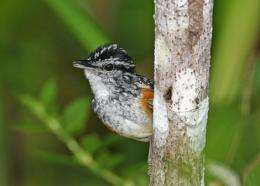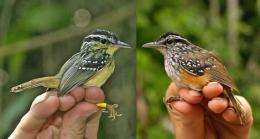Even singers in the bird world have to deal with cover artists

(PhysOrg.com) -- Two competing species of Amazonian birds use the same songs to communicate with each other, Oxford University scientists have found, the first evidence that convergent evolution can arise through social interactions between species.
Two competing species of Amazonian birds use the same songs to communicate with each other, Oxford University scientists have found, the first evidence that convergent evolution can arise through social interactions between species.
A report of the research, published today in the journal Evolution, describes how ongoing research into antbirds living in the rainforests of Peru has shown that two species compete over territories and use nearly identical territorial songs. This is despite the fact that they have evolved strikingly different non-territorial signals, such as calls and plumage colour.
‘What is remarkable is that these two species, the Peruvian antbird and the yellow-breasted antbird, last shared a common ancestor more than 3 million years ago and yet, in the rainforests today, they have evolved to sing the same territorial song,’ said Dr Joseph Tobias, of Oxford University’s Department of Zoology, who led the work with Oxford colleague Dr Nathalie Seddon. ‘It’s almost the equivalent of humans and chimpanzees using the same language to settle disputes over resources.’

In nature there are many examples of convergent evolution - such as the independent evolution of wings in birds and bats - but the idea of convergent evolution in communication signals is controversial, as many scientists argue that such crossover would lead to needless confrontation, and costly hybridisation, between species.
In order to test the idea that different antbird species might have evolved similar songs to communicate, the Oxford scientists recorded 504 songs from 150 individuals in locations where the two species were separate, and locations where they lived side-by-side, as well as songs of other more closely related species from South America. They then played back the recordings to individuals of both species and observed their reactions.
What they found was that similar-sounding territorial songs of both species were regarded as equally threatening, whereas the different-sounding songs of other more closely related birds produced weaker responses.
Dr Tobias said: ‘Our results provide the first compelling evidence that social interaction can cause convergent evolution in species competing for space and resources. They also suggest that such convergence may be offset by rapid evolution of differences in non-competitive signals, such as plumage colour, to reduce the chances of interbreeding.’
More information: A report of the research, ‘Signal design and perception in Hypocnemis antbirds: evidence for convergent evolution via social selection’, is published online in Evolution.
Provided by Oxford University
















